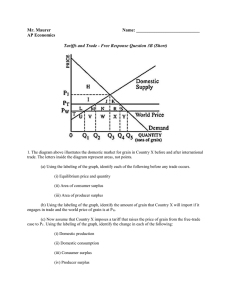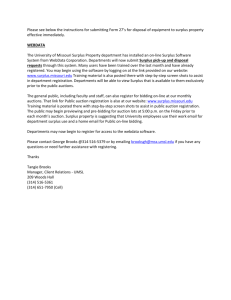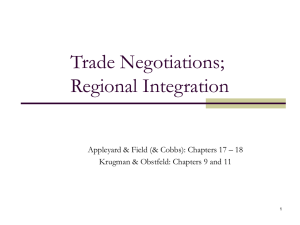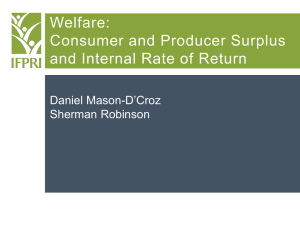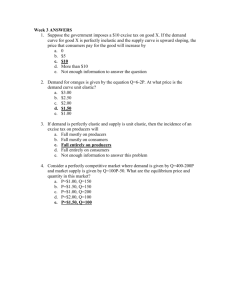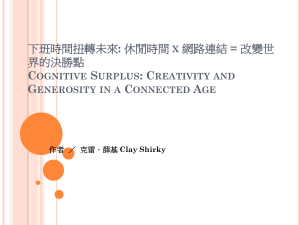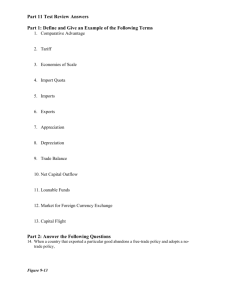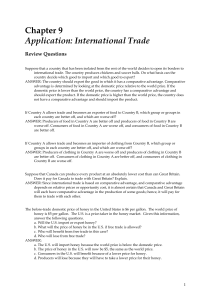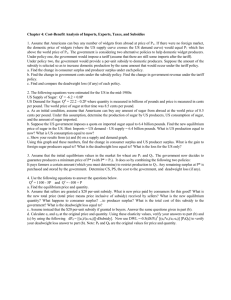here are the solutions
advertisement
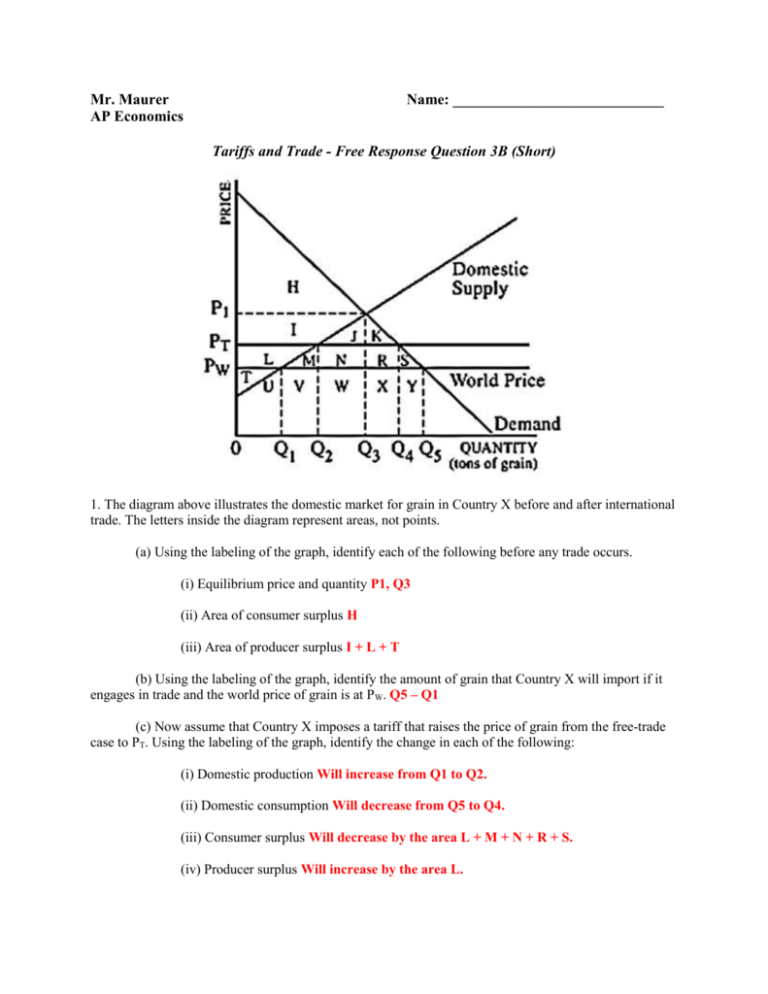
Mr. Maurer AP Economics Name: ____________________________ Tariffs and Trade - Free Response Question 3B (Short) 1. The diagram above illustrates the domestic market for grain in Country X before and after international trade. The letters inside the diagram represent areas, not points. (a) Using the labeling of the graph, identify each of the following before any trade occurs. (i) Equilibrium price and quantity P1, Q3 (ii) Area of consumer surplus H (iii) Area of producer surplus I + L + T (b) Using the labeling of the graph, identify the amount of grain that Country X will import if it engages in trade and the world price of grain is at PW. Q5 – Q1 (c) Now assume that Country X imposes a tariff that raises the price of grain from the free-trade case to PT. Using the labeling of the graph, identify the change in each of the following: (i) Domestic production Will increase from Q1 to Q2. (ii) Domestic consumption Will decrease from Q5 to Q4. (iii) Consumer surplus Will decrease by the area L + M + N + R + S. (iv) Producer surplus Will increase by the area L. Mr. Maurer AP Economics Name: ____________________________ Tariffs and Trade - Free Response Question 4 (Short) 1. The graph above shows the demand for oil by United States residents, the supply of oil by United States producers, and the world price of oil. Use the labeling of the graph to answer the following questions. (a) Identify the following before international trade occurs. (i) Price of oil in the United States market. P2 (ii) Quantity of oil produced in the United States. Q2 (b) Now assume that the United States begins to import oil at the world market price of PW. Identify the quantity imported by the United States. Q3 – Q1 (c) Identify the consumer surplus in the United States market for each of the following cases (i) Before international trade KGP2 (ii) After international trade KHPw (d) Identify the producer surplus in the United States market for each of the following cases. (i) Before international trade P2GP1 (ii) After international trade PwJP1 (e) Identify the net gain in total surplus from trade. JGH Mr. Maurer AP Economics Name: ____________________________ Tariffs and Trade - Free Response Question 4B (Short) 1. The diagram above shows the domestic supply and demand for good X in the country of Placonia. (a) If the current world price of good X is Pw, does Placonia export or import good X? Explain. Import. At Pw, domestic producers would produce 50 units, while domestic consumers would demand 350 units. The difference would be made up through imports. (b) Given your answer in part (a), indicate the quantity of good X that Placonia exports or imports. 300 units. (c) Assume that the government of Placonia imposes a tariff on good X, increasing the price from Pw to Pt. Using the labels in the graph, indicate the change in each of the following in Placonia. (i) Consumer surplus Decreases by the area PtMNPw (ii) Producer surplus Increases by the area PtKJPw (d) Indicate how employment in the domestic industry that produces good X is affected by the tariff. Employment would increase in the domestic industry that produces good X because domestic production would increase. Mr. Maurer AP Economics Name: ____________________________ Tariffs and Trade - Free Response Question 12 (Short) 1 Sugar is freely traded in the world market. Assume that a country, Loriland, is a price taker in the world market for sugar. Some of the sugar consumed in Loriland is produced domestically while the rest is imported. The world price of sugar is $2 per pound. The graph below shows Loriland’s sugar market, and PW represents the world price. (a) At the world price of $2 per pound, how much sugar is Loriland importing? 12 million pounds. (b) Suppose that Loriland imposes a per-unit tariff on sugar imports and the new domestic price including the tariff is $4. (i) Identify the new level of domestic production. 6 million pounds. (ii) Calculate the domestic consumer surplus for Loriland. You must show your work. (($9 - $4) x 10 million pounds of sugar) x ½ (area of a triangle) = $25 million. (iii) Calculate the total tariff revenue collected by the government. You must show your work. ($4 - $2) x (10 million – 6 million) = $8 million The value of the tariff is $2 and is collected only on the 4 million pounds of imported sugar. (c) Given the world price of $2, what per-unit tariff maximizes the sum of Loriland’s domestic consumer surplus and producer surplus? Zero. Total surplus is always greatest without interference in the market. A tariff always decreases total surplus.
